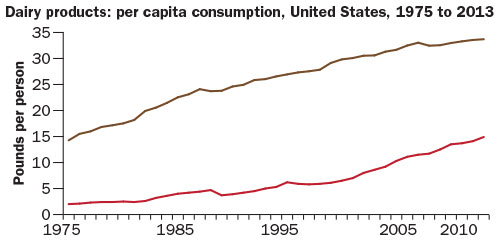
Accounting for 15 to 17 percent of all U.S. dairy production in recent years, dairy product exports have been rightfully grabbing headlines as of late. So, too, should cheese and yogurt as they have been carrying domestic product sales. When digging deeper into the sales data, each product category writes a compelling story.
The yogurt category notched sales of 14.9 pounds per person in 2013, according to recent USDA data. What most people may not know is that the average American ate only 7 pounds of yogurt in 2001. That means in just a short 13-year window, consumers doubled their appetite for yogurt. At 8 ounces per cup, that represents an additional 15 cups of yogurt since 2001. Multiplying that by the 319 million people living in this country, that's 4.8 billion additional cups of yogurt each year compared to 2001.
Yogurt still has a great upside despite the recent growth.
"In the Netherlands, consumers eat a cup of yogurt each day. In the U.S., that number hovers between a cup each week to one cup each month," explained Libby Costin who heads up global marketing at Tetra Pak. "As commute times to work go up, more people are eating on the go," she said, noting that yogurt helps to fill that market space.
While the yogurt story is just unfolding, cheese has made headlines for decades. The impressive run for cheese began in the 1970s and has continued to this very day. In 1978, consumers each ate 16.8 pounds of curd annually, according to USDA data. Some 36 years later, that number has doubled to 33.7 pounds in 2013.
While multiple cheese varieties have contributed to the cause, Mozzarella would earn purple ribbon honors . . . largely due to our growing appetite for pizza. Mozzarella consumption has grown from 1978's 2.68 pounds to 10.82 pounds over that span.
 Also adding to cheese growth since 1978 were:
Also adding to cheese growth since 1978 were:- Cheddar, up 2.7 pounds to 9.7 pounds
- Provolone, up 0.7 pound to 1.1
- Parmesan, up 0.7 pound to 1
- Ricotta, up 0.3 pound to 0.7
- Muenster, up 0.2 pound to 0.48
- Blue, up 0.1 pound to 0.3








